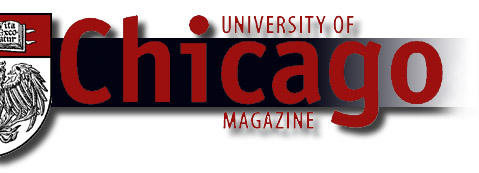|

Birds of Hyde Park
I’m glad that
a zoologist as renowned as Stephen Pruett-Jones has declared that
Hyde Park’s colorful monk parakeets don’t appear to pose an environmental
threat (“Investigations,” October/98).
Having lived
for several years in the vicinity of “Parrot Park,” I recall being
amazed and uplifted by the incongruous sight of tropical birds in
flight on a bitter-cold Chicago day. Then came reports that government
agents were plotting to exterminate the creatures—until a formidable
assemblage of Hyde Parkers came to the parakeets’ rescue.
There might
be an X-Files plot hidden somewhere in this tale, but the lesson
I took from it was more along the lines of that worn cliché “birds
of a feather.” Hyde Parkers and monk parakeets both possess an unforeseen
ability to adapt to environmental extremes—and both species put
up a hell of a squawk if you make the mistake of riling them.
Ian O. Rinth
Twin Falls,
Idaho
Strictly
speaking
I don’t normally
correct minor mistakes, but the lack of understanding of science
and the nature of “organic” and “inorganic” exhibited by the editor
(“Editor’s Notes,” October/98) is frightening. Just because a piece
of plastic doesn’t behave the way a leaf does, does not make it
inorganic. The definitions are usually simple: Compounds that contain
mostly carbon are “organic”; compounds containing little or no carbon
are “inorganic.” Most plastics are organic because they are made
of carbon, hydrogen, and other elements. These compounds don’t biodegrade
because there are few “bugs” that have evolved to use them as food.
Cellulose, one of the major ingredients of wood is (horrors) a “plastic.”
I hope she will learn a little about science before she graduates.
W. S. Zimmt,
PhB’47, SB’47, SM’49, PhD’51
Tucson, Arizona
The editor,
who has graduated (twice, though not from the University of Chicago),
offers in her defense the fact that she was using the words in their
figurative sense (which, like their scientific meanings, are included
in the dictionary).—Ed.
An
ad is an ad is…
Thirteen of
the 14 letters in the October/98 issue are appropriate comments
on prior editorial content or letters in this Magazine. The last
(“Respondez s’il vous plate”) is self-admittedly a request
from a (presumably profit-seeking) antiques dealer for offers on
some U of C–related materials. This veiled advertisement belongs
in a paid sidebar along with other ads for profit-making entities
in the issue, including a furnished apartment-style hotel and a
dating service. This content does not serve the readership as an
amplification of or comment upon the University or the Magazine
and should not be published in this manner.
Richard A.
Sachs, AB’70
Chelmsford,
Massachusetts
Although
we thought we were providing alumni with a service, Mr. Sachs makes
a good point; we won’t do it again.—Ed.
Strike
two
In response
to a letter by Norman L. Macht, PhB’47, in the October/98 issue
of the Magazine, the editor states that “Macht is correct
in noting that Baltimore Orioles second baseman Roberto Alomar was
ejected during a September 27, 1996, game against the Toronto Blue
Jays, for spitting in umpire John Hirschbeck’s face.” That is not,
in fact, correct.
While it may
seem, on the surface, like a technical distinction, Alomar was ejected
before the spitting incident, a fact that, in the context of the
situation, was extremely important. The spitting incident itself,
while reprehensible, was part of Alomar’s enraged—and admittedly
palpably excessive—response to his very questionable ejection for
mildly objecting to a horrific called third strike in a crucial
game.
Kerry M. Leibowitz,
AM’88
Glen Ellyn,
Illinois
Gang
equality
The drug-selling
gang studied by Steven Levitt and Sudhir A. Venkatesh, AM’92, PhD’97,
(“Gang Economics,” October/98) is economically more democratic than
the typical big national corporation.
The “foot soldiers”
of both gang and corporation receive no more than the minimum wage—and
less in the case of the corporation if it does its manufacturing
in the Third World—but the gang leader took in only $100,000 a year,
while his corporate equivalent, the CEO, often pockets several million.
Herbert J.
Gans, PhB’47, AM’50
New York City
Treaders
vs. non-treaders
Sociologist
Andrew Abbott, AM’75, PhD’82, invited explanations of the relation
he found between having stepped on the U of C seal and not having
graduated within four years (“Seal of Approval,” College Report,
October/98). There are two promising hypotheses, not mutually exclusive.
The first involves cognitive ability.
My recent article
in Intelligence, “Everyday Life as an Intelligence Test”
(January-February/97), reviewed evidence for an inverse IQ link
to many kinds of deviant behavior, especially when data were aggregated
over many individuals. Hence, one might compare the SAT scores,
if available, of the treaders and non-treaders, those who graduated
in four years and those who did not, and proceed from there. I would
be curious whether verbal and quantitative SAT scores each played
an independent role.
Arguing against
finding a connection with SAT scores is the fact that the deviant
acts in question were mild ones and the relation is more likely
to emerge when the normative departure is not trivial. Furthermore,
U of C undergraduates are concentrated within a narrow range of
intelligence (88 percent with SAT scores of 1200 or more in the
class of 2002, a threshold corresponding roughly to an IQ of 130).
Restriction of range militates against finding correlations between
variables. Conceivably, too, brighter individuals would be less
respectful toward arbitrary authority, and so step on the seal,
although they might still graduate easily in four years. Nonetheless,
the hypothesis is worth testing.
Integrity is
the second hypothesis (“The Construct Validity of Integrity Tests,”
Ph.D. dissertation by Deniz S. Ones, University of Iowa, 1993).
As measured by a variety of conscientiousness and broader integrity
scales, this variable has been found to add to the predictability
of job performance beyond the strong effect of general intelligence,
which is the best independent predictor for most jobs. Being a student
is a kind of job (payment deferred). Hence, Abbott’s two behaviors
may be linked because both are manifestations of conscientiousness.
As females score higher in conscientiousness, the hypothesis might
be tested indirectly by comparing sexes, perhaps holding SAT scores
constant. Alternatively, students could be observed at the seal
and a conscientiousness test administered at a later date to those
who step on or respect the seal, once sufficient sample sizes have
been reached.
Evidence for
either or both hypotheses involving such an esoteric little specimen
of behavior as stepping on the U of C seal would be gratifying indeed
to theorists of behavior concerned with outcomes of seemingly much
weightier social consequence.
Robert A.
Gordon, AM’62, PhD’63
Baltimore
Andrew Abbott
replies: We don’t have the respondents’ SAT scores, but gender makes
no difference either in whether you “stepped” or in rates of graduation
given stepping or not stepping. My own theories involve response
bias. If you didn’t graduate in four years, you’re more likely to
remember the plaque and whether you stepped on it. But graduation
rates are the same for those who don’t remember as for those who
do remember but didn’t step. So there must be a further effect.
My guess
is that once the pain of late graduation is over, the plaque story
makes good party chitchat. So people who took more than four years
shade their memories that way.
Inclined
hearts
Arthur and
I didn’t meet at the University, but we certainly became better
acquainted because of it. I had never had any trouble following
and learning anything in the classroom until it finally dawned on
me that eventually I would have to take a six-hour exam covering
the sciences survey course, some parts of which may as well have
been some kind of unrecognizable flying objects that somehow came
together to form what?
One of my
friends felt the same desperation. Help! And we found it. I had
had a few dates with Arthur Kohn, who had several degrees from the
University of Michigan, and when I told him my problems, he agreed
to tutor my friend and me. Somehow, he got through to us. I even
managed to remember (maybe just until the exam was over!) whatever
I had to remember in order to solve whatever I had to learn about
that “plane that inclined.”
And Arthur
and I went on from tutor and student to man and wife.
Joyce Bodenheimer
Kohn, AB’37
Mayfield Heights,
Ohio
Good
articles, but bad type
I recently
received an invitation to renew my subscription to the Magazine.
I do not plan to do so, but it seemed rather gauche just to throw
the invitation in the trash without an explanation.
My eyesight
is poor, and the Magazine has lots of text printed in fonts
which are probably perfectly adequate for the average user, but
hard for me to read. A “good read” for me these days is to settle
down in a comfortable chair to listen to a recorded book or magazine.
Most of my other reading has to be done with a magnifying glass
or on the computer screen where I can change the letters to white
on a black background and enlarge them.
A second reason
for writing this note is to suggest that you might consider alternative
ways of publishing the Magazine. I am currently quite interested,
for example, in the developments in voice synthesis software, which
can “read” electronic text.
All this aside,
the Magazine is a very good one.
George H.
Thomson, PhD’63
Santa Fe, New
Mexico
The
mystic soul
Statements
about U of C students in Sam Portaro’s “Acts of Faith” (June/98)
to the effect that they are “more ‘spiritual’ than ‘religious’”
and that “curiosity prevails over conversion” suggest some students
would be interested in a succinct exposition of religion as science—that
is, the science of the soul that is mysticism.
The word “mystic,”
from the ancient Greek mystes, denotes a person who has been
initiated into certain mysteries. Idries Shah, who has published
a number of books of Sufism, the mystical branch of Islam, defines
mysticism thus: “Mysticism is not a religion. It is religion. It
is the essence of all religions.” Alan Watt in his opening lecture
of the “Great Books of Asia” series presented in the mid-1950s on
public radio and public television, defined mysticism as “the knowledge
of man’s true nature and destiny,” and added that such knowledge
is the result of experience as specific and concrete as anything
experienced by our physical senses. In that lecture, incidentally,
Watt also points out in some detail what he felt to be a weakness
in the Great Books system of education.
In secular
terms, mysticism is about growth—the growth of a human being—because
mysticism is the means that enables that growth. The American painter
Kenneth Harris, in his lecture “The Necessity of Non-Conformity,”
asserted that a teacher’s main purpose is to help the student grow.
Mysticism is a path, a way, an actual highway—the royal highway—which
leads from here to the abode of the Supreme Being. As Tennessee
Williams rightly asserts in Camino Real, planet earth is
located at the nether end of the Royal Highway.
The incredible
journey upon this highway is, in my opinion, the most wonderful
adventure open to a human being.
George M.
Colby, PhB’49, AM’52
Murrieta,
California
The Magazine
invites letters on its contents or on topics related to the University.
Letters must be signed and may be edited. Write: Editor, University
of Chicago Magazine, 1313 E. 60th St., Chicago, IL 60637. E-mail:
uchicago-magazine@uchicago.edu.
|



